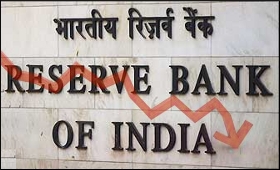|

|
RBI cuts repo rate by 25 bps; no change in CRR
|
|

|
|
| Top Stories |
 |
|
|
|
SME Times News Bureau | 02 Jun, 2015
The Reserve Bank of India (RBI) has cut the policy repo rate by 25 basis points from 7.5 percent to 7.25 percent, but left the cash reserve ratio (CRR) of scheduled banks unchanged at 4.0 percent of net demand and time liabilities.
Giving in to overwhelming demands for an easing of the monetary policy, RBI on Monday lowered its short-term lending rate by 25 basis points in a move that could potentially reduce the cost of borrowings on personal and corporate loans.
In his bi-monthly monetary policy review for the current fiscal year at the RBI headquarters here on Mint Street, Governor Raghuram Rajan said the repurchase rate has been lowered to 7.25 percent on the basis of an assessment of the current and evolving macroeconomic situation.
Prior to the review, the repo rate -- the interest rate which the central bank levies while lending short-term funds to commercial banks -- stood at 7.5 percent.
"Consequently, the reverse repo rate under the liquidity adjustment facility (LAF) stands adjusted to 6.25 percent and marginal standing facility (MSF) rate and the bank rate to 8.25 percent," the governor said.
The cash reserve ratio (CRR), the quantum of funds commercial banks have to keep in the form of cash or government bonds, has been left unchanged at 4 percent of deposits.
"Our policy is neither too conservative, nor too aggressive -- but just right for the given moment," Rajan said at a post-review press conference, and made it clear that he would like to see the commercial banks passing on the rate cuts down the line.
Thus far in this calendar year, the Reserve Bank has cut its lending rate by 75 basis points. But for this to translate into lower interest rates for personal, housing, automobile and corporate loans, commercial banks also have to initiate such an action.
As soon as the statement was updated at 11 a.m., the sensitive index (Sensex) of the Bombay Stock Exchange (BSE) took a dip of over 200 points. At that point, the intra-day fall was as much as 450 points. Half an hour later, the index was ruling with a loss of 360 points or 1.3 percent.
Giving the reasons for the policy stance, Rajan said plans for lower food output needed to be in place, global financial markets were volatile, factory output was recovering unevenly, services sector was emitting mixed signals, fuel inflation was up, exports were down and liquidity had improved.
In the calendar year thus far, the central bank has twice cut the repo rate over two unscheduled monetary policy reviews -- in January and March, bringing it down to 7.5 percent. But during the scheduled reviews in February and April, no changes were effected.
In April, Rajan said banks have to pass on the previous rate cuts, and dismissed claims that cost of funds remained too high. At Tuesday's press conference, Rajan said banks had slowly started to lower interest rates, but the pace was not fast enough.
Ahead of the policy update, while the underlying expectation was for a 25 basis points cut in the lending rates, stakeholders hoped the RBI would spring a surprise by lowering its interest rate by 50 basis points.
Rajan said that the central bank will keep an eye on how monsoon progresses and the steps taken by the government to mitigate its negative effects.
"There have been El Nino in the past as well, like the deficient rainfalls in 2002-03, but the prices were stable and kept under control due to the government's steps," Rajan said.
"There are ways in which the government can step in, like buffer stocks or imports of commodities such as pulses," Rajan said.
The inflation levels for January 2016 have also been hiked to six percent from an earlier estimate of 5.8 percent.
On the revival of investment demand, he said there is a need for "unclogging" of stalled investment projects, stabilising of private new investment intentions, and improving sales of commercial vehicles.
"Industrial production has been recovering, albeit unevenly. The sustained weakness of consumption spending, especially in rural areas as indicated in the slowdown in sales of two-wheelers and tractors, continues to operate as a drag. Corporate sales have contracted," Rajan said.
He said the "disappointing earnings performance" could have been worse if not for the decline in input costs.
The governor added that the first set of new banking licences will be issued by August, taking the number of such private financial institutions operating in the country to more than 12.
India's central bank has licensed 12 banks in the private sector in the last two decades, of which 10 were licensed on the basis of guidelines issued in January 1993.
|
|
|
| |
|
|
|
|
|
|
|
|
|
|
|
|
|
|
| |
| Customs Exchange Rates |
| Currency |
Import |
Export |
US Dollar
|
66.20
|
64.50 |
UK Pound
|
87.50
|
84.65 |
Euro
|
78.25
|
75.65 |
| Japanese
Yen |
58.85 |
56.85 |
| As on 13 Aug, 2022 |
|
|
| Daily Poll |
 |
 |
| PM Modi's recent US visit to redefine India-US bilateral relations |
|
|
|
|
|
| Commented Stories |
 |
|
|
|
|
|
| |
|